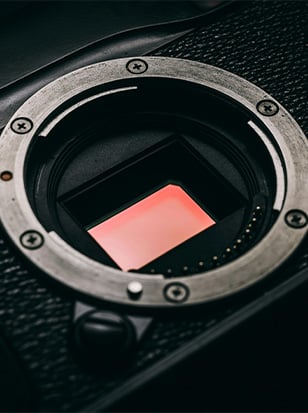
Léonie Hampton is a British photographer renowned for her deeply personal and evocative storytelling. Her work often explores themes of memory, family, and the complexities of human relationships, blending documentary and fine art approaches. Known for her sensitive and intimate imagery, Léonie creates photographs that resonate with emotional depth, inviting viewers into the quiet yet profound moments of everyday life. Through her lens, she not only captures what is seen but also delves into the unseen narratives that shape our experiences.
I was fortunate to speak to Léonie about her practice and explore how she approaches photography. We discussed the relationship between documentary photography and photojournalism, and how her creative process has changed over time.
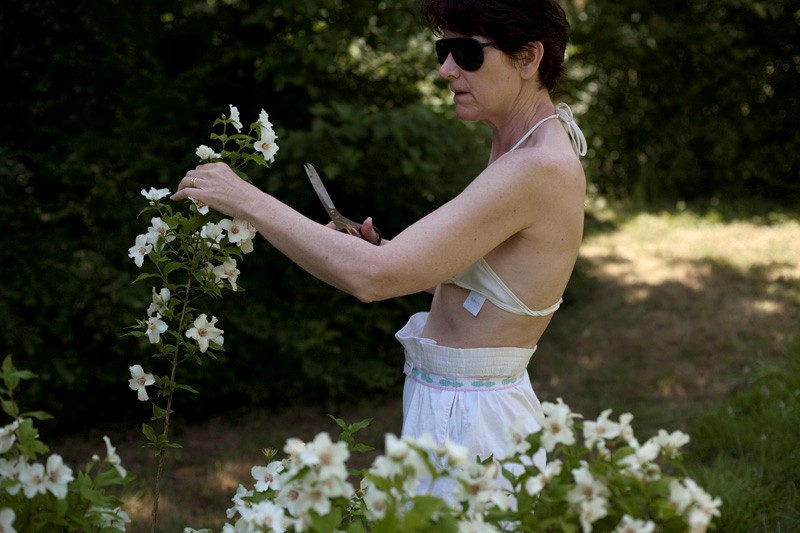
Bron #8 From the series In the Shadow of Things
Leo White: To start with, for anyone unfamiliar with your work, could you talk about the underlying themes and what drives your creative choices?
Léonie Hampton: Well, right now I’d say the themes that interest me most are quite classic – the question of our humanity, trying to understand my journey and my growth as a human being. It’s quite a philosophical outlook. “How do I make the most of being human, what’s my responsibility for being here in this time?”
From that point, I ask myself: What’s the pain? What’s blocking love, care; the ability to live in this world? Everywhere I look, I see the opposite energy – war, damage to the planet, or harm to other living beings – it’s just really troubling. And I think in any artist’s practice, whether through photography or another medium, there’s an opportunity to open up that discomfort, to ask, “Why? What needs addressing here so we can mend this, so we can evolve as human beings?”
I really value how photography connects me to that journey; trying to look truthfully in the mirror. But I don’t deny that the mirror’s not crystal clear. It’s full of shadows; things I can’t see, and things I can’t bear to see. And, of course, as a physical being, the camera limits me. What I can access is limited by my body, my being here, in this time, taking this picture. So, photography for me is very much in the present, right in front of me; and it’s the engagement with the mundane, the everyday, that really interests me.
Through that, I see an opportunity to ask bigger, more philosophical questions about our world and who we are. I celebrate that opportunity as a form of learning about myself. I’m wary of calling it therapy – I'm not sure that’s how I experience it – I understand therapy can help you deal with uncomfortable things, and that's about as close as it gets to the word therapy. It helps me confront uncomfortable truths that are personal and matter to me. It’s about transformation, trying to heal, not getting stuck in patterns I don’t want.
The camera has been one of the most powerful tools I’ve found to speed up that process. It shows me something I might have been hiding from and then I have the opportunity to figure out what I'm going to do about that. It’s a magic medium.
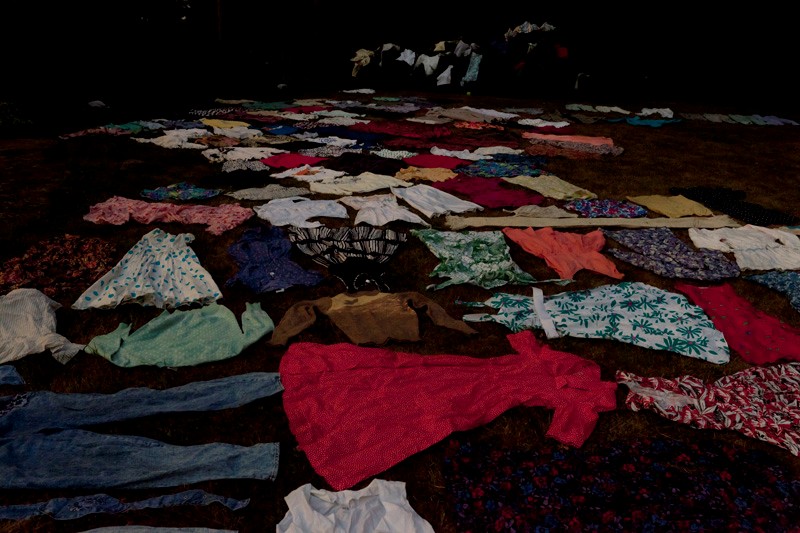
These are not our clothes. From the series In the Shadow of Things
LW: That’s a fantastic answer, really insightful. You've touched on a lot of things, and it’s clear that many of your projects blur the line between documentary photography and fine art. How do you see the relationship between these two approaches?
LH: Photographer Paul Graham once shared a quote from British-Ugandan artist and photographer, Stanley Wolukau-Wanambwa that really resonated with me.
“I think that the way in which the term “documentary”—and its associated meanings—has been sequestered into a narrow and disingenuous relationship with “reality” is not a reason to abandon it, but an imperative to reclaim it in all its myriad complexities…”
It suggests that documentary photography being siloed into a definition doesn’t do justice to its wide potential. It gets reduced to this overly literal idea – just seeing what’s directly in front of you – and this sort of binary back-and-forth makes it kind of boring as an idea. Stanley suggests that because it’s forced into that simplified definition, we should fight even more for what it actually is, which is much deeper.
There's poetry; a dream world; a psyche involved in what the camera is doing. The fact that it's being used traditionally to capture moments doesn't mean that it lacks all the other things that other mediums have – documentary photography is not excluded from those ideas. You’re still a human holding a camera, capturing experiences. The moments [in time] you choose to photograph, the stories you decide to tell, and the way you edit and present your final work all involve layers of complex human experiences.
I’ve noticed exhibitions recently showing work that would usually have been categorised as photojournalism. Sometimes, it feels like there’s still this divide between what’s considered art photography and photojournalism or documentary. And while putting photojournalistic work into a gallery is a good step, it’s important to really think about how we’re engaging with it. There’s so much incredible, artful work, and I think it deserves to be on the same level as some of the other art that’s going on. But at the same time, not all of it is trying to be art, and that’s fine too. It’s important we keep challenging ourselves and evolving the medium.
LW: It’s an interesting perspective. There are definitely different ways of looking at documentary photography and photojournalism. There are purely journalistic, newspaper-type images but also similar photos that tell a deeper story; still within the realm of journalism and documentary.
LH: Yes, and I think there’s a responsibility within journalism to explore more lyrical, emotional, feeling-based images. There shouldn’t be such division between them.
It could be really interesting to see that type of photography in the media. Perhaps the types of images traditionally used in newspaper photojournalism no longer have the same impact they once did in stirring popular movements and understanding.
I think bringing more artful photography into journalism could be interesting. I’m sure there’s a level of that already – I’m not a great newspaper reader – but I'd love to see more of that type of photography, where people don't really necessarily know exactly what they're looking at, but something inside them is moved – something stirs in their heart.
That’s an aspect of my photography that I'm trying to cultivate: to make photographs where you look into it and a feeling is stirred, but you might not consciously know the reasons why. I'm trying to help us find ways to feel so we can face what needs to be addressed.
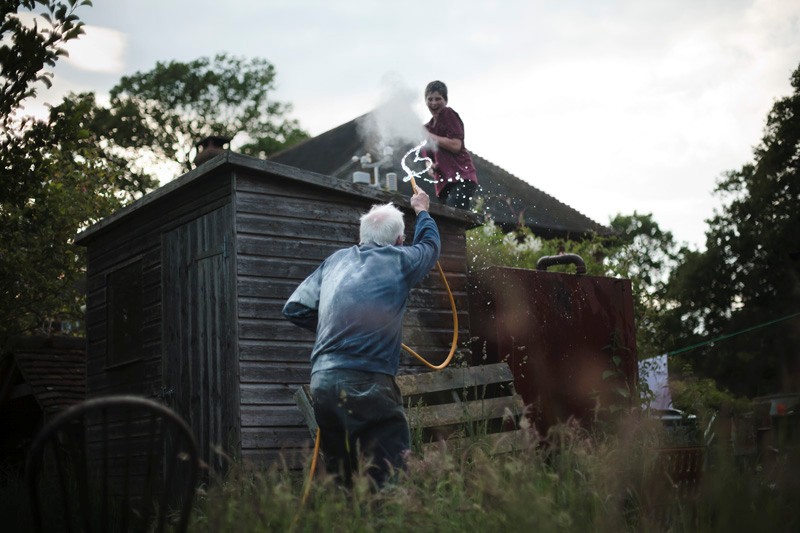
David and Jake #3 From the series In the Shadow of Things
LW: Absolutely. Images can allow a person to feel something. They may not know what it is, but that’s the first step to opening them up to their true feelings.
LH: Exactly. I remember I went to a Magnum exhibition years ago at the Barbican. It was a retrospective featuring various Magnum photographers, and as I walked around the exhibition, I came across the work of Miguel Rio Branco, a Brazilian photographer affiliated with Magnum. His work caught my eye – it was very poetic, lyrical work, with little text. In the bookshop, I found a book of his called “Silent Book”. There are no words inside, just images. I started looking through and started to cry. And to this day, I cannot tell you why.
I’ve looked at that book many times since and I don’t cry every time I open it, but there was something in those images that moved me. It was so cathartic, so beautiful; and experiences like that help me realise my commitment to figuring out that magic. It felt so beautiful to cry and not know why. And in this case, to be free from a worded explanation. I really cherish moments like that and celebrate photography that works on that level.
LW: That’s really powerful. I think about others who’ve had similar experiences, and they don’t always understand why. It can almost confuse or even scare them, especially if they’re a bit repressed emotionally. It’s fascinating how images can do that.
LH: I think there’s an openness and freedom within the visual world. This isn’t just exclusive to photography – anything visual outside of words has an expansive ability to communicate beyond language in text. I think it’s quite bodily. With written language, we analyse inside our head, whereas visual language can run through the body. The body can help us navigate and help us see which way to go – in a way, I trust this a bit more than my analytical head right now.
I think intuition is far richer and wider, but that still includes the analytical. Intuition includes the thinking brain; but it also the body, the heart, knowledge and memory – all these things inside us, in every part of our being. If we only use the analytical brain to guide us, we’ll mess up. That’s how I feel about what’s going wrong [in the world] right now.
We need to reconnect the body as quickly as possible back into the decision-making process, back into being a guiding force. It just feels like such a genuine and powerful tool to face what we’re dealing with today – especially the environmental crisis – which for me, is a human crisis. It’s a reflection of our own troubles. It’s about fixing ourselves; the way we live, the way we are with each other, and the way we are with the world.
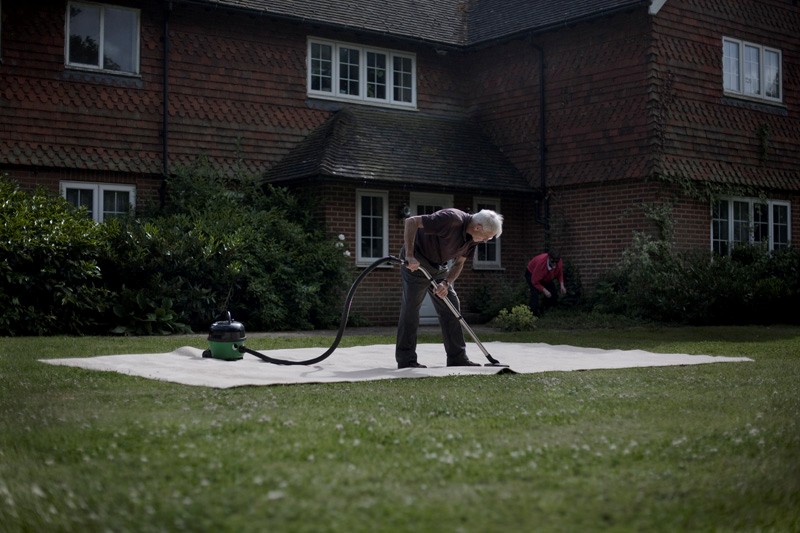
David #4 From the series In the Shadow of Things
LW: We’ve been talking about evocative and deeply personal images. Your work has a distinct style that feels very real – not overly edited. What is your preferred method of working with light and composition to achieve that look? And ultimately, making someone feel something?
LH: That's such a hard one to answer. I mean, I have a real weakness for beauty. I love being stirred by beautiful things. So, I guess I’m always looking for that in the everyday, the mundane, and even in the trouble. A lot of my work deals with difficult, troubling and personal subjects, but I’m always looking for the beauty within them. Without that, it becomes a kind of pure despair. But beauty, to me, is like a hand that reaches out and guides you away from that.
So whether it's just the simplicity of a beam of light falling into a room or the presence of an animal; these moments of beauty are always there for us no matter what kind of conflict, tragedy, or suffering we might be in. That’s what I’m looking for. I wouldn’t say it’s a technical thing. I just try to look for that beauty when I’m working.
In terms of colour, I’ve gone through phases. I’ve had moments when I leaned heavily into post-production, pushing the colours. And, psychologically, I thought that was very interesting. I remember working on In the Shadow of Things and sitting down with someone in post-production who really pushed the colours. I really liked it at the time. I think making the real unreal made it more comfortable for me.
But the braver I became with that work – and where I stand now, 10 years later – I want it to be as real as possible. If you close your eyes and remember a moment you were in; what did the colours look like? What did they feel like? Unlike matching a photograph to its exact time and place, [I want them to look] real in the sense of memory and feeling. That's the type of colour field I'm looking for when making a decision.
LW: With that in mind, how do you feel about the idea of exaggerated memories? How we remember things aren’t always exactly as they were. Does that come into play with your choices?
LH: That’s an interesting question, isn’t it? Because I think about how things are at that moment; I’m standing here now, looking out of the window, seeing the grass, the light, the sheep, and the trees in front of me; but I’m also carrying a feeling inside of me. The emotional space I’m in, what’s happening in my psyche right now. That’s just as much a part of the reality I’m experiencing when I look out of the window.
So, the kind of reality I’m talking about is that dual reality. The one that looks out through your eyes but also looks inside yourself. When I talk about real colour or the final image; that’s what I mean. I don’t shift colours much; I tend to keep them simple, as they were. But if I do adjust something, it’s because I believe that adjustment reflects what’s real.
And I think a lot of confusion and disagreements between people happen because we forget that. We forget we’re all bringing so much into each moment – our feelings and experiences – and that’s unique to each of us. Through art and photography, one can express a bit of that.
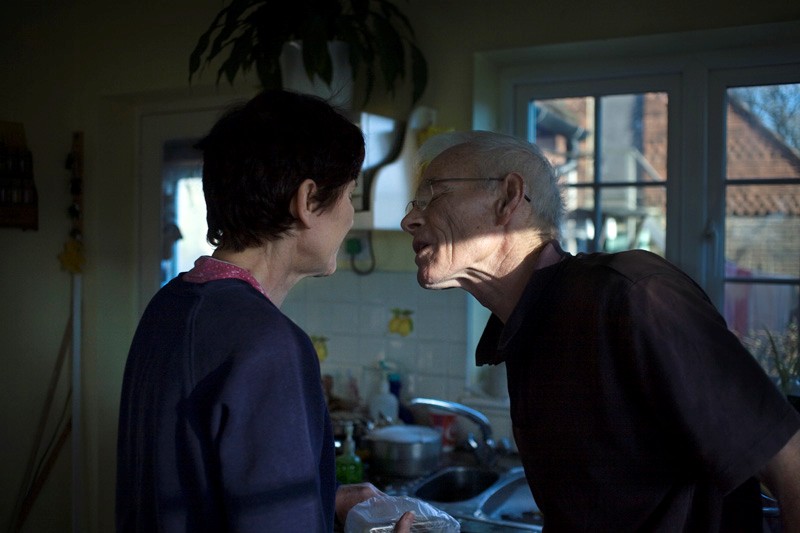
David and Bron #1 From the series In the Shadow of Things
LW: How do you approach a new project? Do you have a clear vision at the start and how does that process evolve?
LH: If I think about In the Shadow of Things, I can recognise that, as a child, I felt angry at a world that misunderstood my mother. In the same way a visual image can communicate things you can’t articulate through words; being within her orbit allowed me to understand certain things about her pathologies – her OCD and hoarding – which I didn’t see reflected or understood in the world around me. As a result, I didn’t want to engage with the literature on those topics. I didn’t want to be told how to think about it. So, I avoided research outside of my own experience and made work that deliberately didn’t engage with that.
At the time, my husband was doing parallel work where he engaged with that kind of material, and he’d occasionally share things he thought were helpful. Looking back, I can see I was quite defensive – defensive of my mother and of the situation. There probably was lots of helpful literature out there, but I wasn’t in the right place to engage with it.
Ultimately, the work I made was about walking through my family’s and my psyche, mapping that journey and photographing my way through it. I’ve sometimes described it as being inside an egg, trying to crack out of it, whereas my earlier work – before In the Shadow of Things, where I was working with other families – felt more like being outside the egg, trying to crack in. It was a very different feeling and direction.
So, I didn’t do much research back then, but now I do research quite a lot when I’m going into a new project. Over the past ten years, particularly film work, I’ve become more comfortable immersing myself in other people’s knowledge.
For example, in a recent project – Our Body of the Planet – I worked with scientists studying fungi. It was fascinating being immersed in a world of knowledge I knew very little about. I felt like a child learning something new for the first time; allowing myself to be a kind of litmus test inside this other world.
There I was, inside the medical mycology unit of the University of Exeter, surrounded by these incredible scientists studying pathogenic fungi. And it was just, you know, this whole world of learning, completely out of my world. But always, it was me inside that other world of fungi, and I never lost sight of that. And, the work I did reflected that.
I think that was always their intention. They didn’t want someone knowledgeable about fungi coming in and making work. They were interested in having an artistic response to their scientific research. So, it became this really interesting collaboration. It was very much a peer-to-peer, bringing together of different skills into one place: one very scientific and one very artistic, but both working (and trying) together to make something powerful.
LW: And finally, could you talk about any recent or upcoming projects that excite you?
At the minute, in terms of photography, I’m most excited about a project on psychosis. It’s something I have been thinking about and gently researching for years, knowing that I would one day make work on the topic.
I’m in conversation with different academics at King’s College London and applying for funding to make the work happen with them. It’s in its early stages, but I’m really excited about it. And I think it will very much be an extension of In the Shadow of Things, in terms of that vernacular and that part of my work being very personal. Psychosis remains very personal for me. Yeah, I’m kind of semi-terrified. I can hear it, but that’s a good thing. You know, it’s going to be important.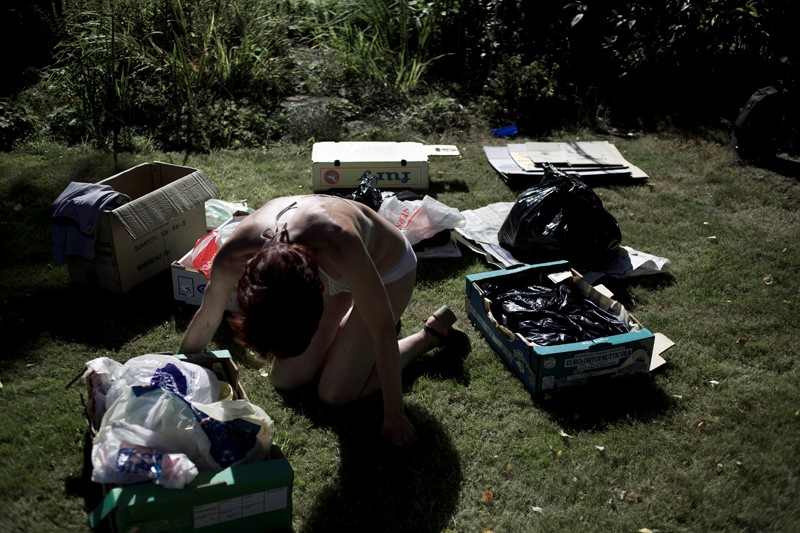
Bron sorting #1 From the series In the Shadow of Things
Check out our interviews...
About the Author
Leo White has been a member of the Wex Photo Video team since 2018, working in a variety of roles ranging from the contact centre to the product setup team. With both a photography BA and MA, Leo has a wealth of knowledge he's ready to share.






